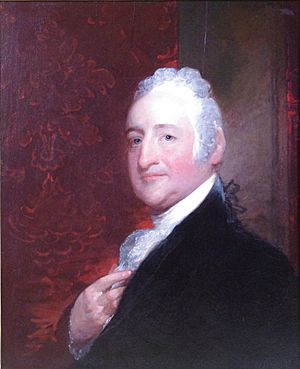George Frederick Cooke facts for kids
Quick facts for kids
George Frederick Cooke
|
|
|---|---|

portrait by Gilbert Stuart
|
|
| Born | 17 April 1756 |
| Died | 26 September 1812 (aged 56) |
| Nationality | British |
| Occupation | actor |
George Frederick Cooke (born April 17, 1756, in London – died September 26, 1812, in New York City) was a famous English actor. He was known for his exciting acting style and helped start a new way of performing called the romantic style. Later, another famous actor named Edmund Kean became well-known for this same style.
Contents
Cooke's Acting Journey
George Frederick Cooke grew up in Berwick-upon-Tweed. When he was young, he worked for a printer. But he soon discovered his love for acting after seeing traveling actors perform. He decided to become an actor himself.
Starting His Acting Career
Cooke first appeared on stage when he was 20 years old in Brentford. He performed in London in 1778 at the Haymarket Theatre. However, he soon went back to touring around the country, performing in many different cities like Hull and Liverpool.
He became very well-known in these smaller cities. In 1794, he played the role of Othello in Dublin and became a top actor there. By 1800, people in London were calling him the "Dublin Roscius," which meant he was a very skilled actor, like a famous Roman one. Cooke spent a long time learning his craft in different towns, which helped him become very good. He started with romantic lead roles but later found his strength playing tricky characters and villains. He knew over 300 different roles!
Performing in America
Cooke wasn't happy with how the London newspapers treated him. So, in 1810, he decided to travel to the United States. American audiences loved him! He first performed as Richard III in New York on November 11.
He traveled to many cities, including Boston, Baltimore, Philadelphia, and Providence. A famous artist named Thomas Sully painted him as Richard III, and it's considered one of Sully's best paintings. Cooke earned a lot of money, but the theater owners made even more, which made him feel unfairly treated.
He planned to return to London in 1812, but the War of 1812 started, and he couldn't leave New York. He passed away in Manhattan on September 26, 1812. He was buried in St. Paul's churchyard in New York.
Later, in 1821, Edmund Kean built a monument to Cooke's memory in St. Paul's chapel in New York. There are some interesting stories about Kean and Cooke's remains, but they are likely just legends.
Cooke's Personal Life
George Frederick Cooke's personal life was sometimes difficult. He was known for spending money freely, which meant he often didn't have much saved up. He married later in life. In 1808, he married Sarah Lamb in Edinburgh. She traveled with him for a while, but they later separated. In New York, he married Violet Mary Behn. When he passed away, he had only a small amount of money left from his long career as a famous actor.
Cooke's Acting Style
George Frederick Cooke is often seen as the first truly romantic actor in England. He learned from older actors like Garrick and Macklin, who he watched when he was young. He made their natural and informal style even more expressive. The fact that Edmund Kean looked up to him shows how important his style was. Critics often compared his energetic style to the more formal acting of Kemble.
Cooke was about 5 feet 10 inches tall and had a strong presence on stage. People said he had a "tremendous force" in his performances. His voice sometimes became rough during long plays, but he was a very active and physical performer, much like Garrick. People also noticed how well he used his eyes to show deep thoughts and feelings. He could even whisper on stage, and everyone in a large theater could hear him!
Cooke was best at playing charming villains or tricky characters. In comedies, his roles as Macsarcasm and Shylock were considered unbeatable. In tragedies, besides Richard III, he was a memorable Iago. Even though King Lear wasn't one of his main roles, his way of showing Lear's madness influenced other actors like Kean.
However, critics often felt he wasn't as good in roles that needed a calm or refined touch. His performance as Hamlet was not successful. People said that as Macbeth, he only showed "low cunning." Some critics believed Cooke was too rough for the most important tragic roles. They thought he made Shakespeare's beautiful poetry sound like angry everyday talk.
As Richard III, Cooke's performance was different and better than Kemble's calmer version. Cooke was great at showing Richard's terrible joy, especially in violent scenes. But unlike Kemble, Cooke also showed that Richard felt disgusted with himself. This made Richard's character deeper, showing he slowly realized how evil he was. Cooke's Richard was more than just a simple villain.
There's a fun story, probably not true, about Cooke trying to impress visitors with his acting skills. He made many faces to show different emotions. But one face confused everyone. They guessed rage or anger, but Cooke finally said it was meant to be love! This story shows that while he was a powerful actor, he might have had limits in showing subtle emotions.
Cooke's Legacy
The Scottish writer John Cargill Thompson wrote a play called The Actor's Apology. This play is about a time when Cooke had to apologize to an audience for a performance where he had some difficulties.

